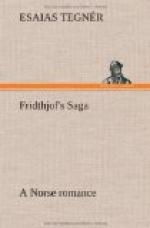Odin. The chief of the gods. He is
the all-pervading spirit of the world, the governor
of the universe, the author of war and the inventor
of runes and of poetry. In appearance he is
old, tall, one-eyed and long-bearded. He wears
a broad-brimmed hat and a many-colored coat, and carries
a spear called Gungner. Odin’s birds.
Odin has two ravens, Hugin and Munin (reflection and
memory), which every day fly around the world and
return to him with intelligence of all that happens.
Peasant. The piece of lowest rank in chess;
a pawn. Ragnarok (the twilight of the gods).
The day of the destruction of the world, and of the
regeneration of gods and men. See Canto XXIV.
Ran (the robber). Goddess of the sea; wife
of AEger. Rota. One of Valhal’s
maidens; a valkyrie. Runes. The letters
of the ancient Scandinavian alphabet were called runes
(secrets). The runes were sixteen in number, and
previous to the introduction of Christianity they
were supposed to have been invented by Odin himself.
A knowledge of them was for a long time confined
to a few, who use them for the purposes of sorcery.
Rune-stone. A stone inscribed with runes,
and set up at graves or elsewhere as a monument.
Saga. Goddess of history; hence a history.
Seming. A son of Odin. The early kings
of Norway traced their lineage directly to Seming.
Signe. See Hagbart Skinfaxe (shining
mane). The horse of Day. Skoal.
A health. Skuld. The future.
See Norns. Sleipner (the slipper).
Odin’s course with eight feet. Sokvabek.
Dwelling of Saga. SURT. God of fire.
Thing (pronounced ting). A deliberative
assemblage of Norsemen, composed of all who were capable
of bearing arms. It was held in the open air.
The thingsmen expressed approval of any measure by
striking the shield with the sword. Thor.
The second of the gods; the thunderer; the subduer
of the frost giants. He has a red beard; his
weapon is a short-handled hammer called Mjolner.
He is girt with a belt of strength, and wears iron
gloves. His sons are Magne and Mode, strength
and courage. Urd. The past. See
Norns. Urd’s fount. The
fountain from which the norns sprinkled the tree Ygdrasil.
Utgard-Loke. The Loke of the Giants,—called
Utgard, because he dwelt in the uttermost parts of
the world, Jotunheim. Vala. A prophetess.
Valaskjalf. Odin’s dwelling.
Valhal (the hall of the slain). Only those
who fell by wounds received in battle, or self-inflicted,
were entitled to the joys of Valhal, where they were
feasted by Odin and attended by the valkyries.
VALKYRIES (choosers of the slain). Goddesses
who serve in Valhal and go on Odin’s errands.
Var. The goddess who presides over marriages.
VEGTAM. A name assumed by Odin when he went to
consult the vala concerning the fate of Balder.—See




